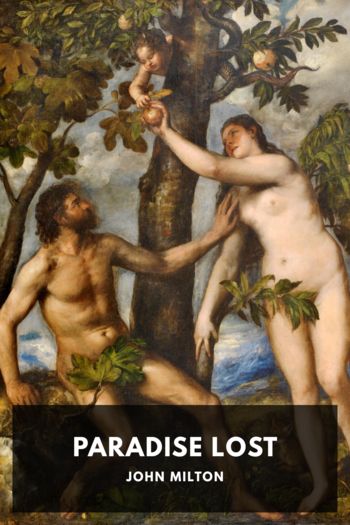Table-Talk by William Hazlitt (best pdf reader for ebooks txt) 📕

- Author: William Hazlitt
Book online «Table-Talk by William Hazlitt (best pdf reader for ebooks txt) 📕». Author William Hazlitt
If a little varnishing and daubing, a little puffing and quacking, and giving yourself a good name, and getting a friend to speak a word for you, is excusable in any profession, it is, I think, in that of painting. Painting is an occult science, and requires a little ostentation and mock-gravity in the professor. A man may here rival Katterfelto, “with his hair on end at his own wonders, wondering for his bread”; for, if he does not, he may in the end go without it. He may ride on a high-trotting horse, in green spectacles, and attract notice to his person anyhow he can, if he only works hard at his profession. If “it only is when he is out he is acting,” let him make the fools stare, but give others something worth looking at. Good Mr. Carver and Gilder, good Mr. Printer’s Devil, good Mr. Billsticker, “do me your offices” unmolested! Painting is a plain ground, and requires a great many heraldic quarterings and facings to set it off. Lay on, and do not spare. No man’s merit can be fairly judged of if he is not known; and how can he be known if he keeps entirely in the background?87 A great name in art goes but a little way, is chilled as it creeps along the surface of the world without something to revive and make it blaze up with fresh splendour. Fame is here almost obscurity. It is long before your name affixed to a sterling design will be spelt out by an undiscerning regardless public. Have it proclaimed, therefore, as a necessary precaution, by sound of trumpet at the corners of the street, let it be stuck as a label in your mouth, carry it on a placard at your back. Otherwise, the world will never trouble themselves about you, or will very soon forget you. A celebrated artist of the present day, whose name is engraved at the bottom of some of the most touching specimens of English art, once had a frame-maker call on him, who, on entering his room, exclaimed with some surprise, “What, are you a painter, sir?” The other made answer, a little startled in his turn, “Why, didn’t you know that? Did you never see my name at the bottom of prints?” He could not recollect that he had. “And yet you sell picture-frames and prints?”
“Yes.”
“What painter’s names, then, did he recollect: did he know West’s?”
“Oh! yes.”
“And Opie’s?”
“Yes.”
“And Fuseli’s?”
“Oh! yes.”
“But you never heard of me?”
“I cannot say that I ever did!”
It was plain from this conversation that Mr. Northcote had not kept company enough with picture-dealers and newspaper critics. On another occasion, a country gentleman, who was sitting to him for his portrait, asked him if he had any pictures in the Exhibition at Somerset House, and on his replying in the affirmative, desired to know what they were. He mentioned, among others, the Marriage of Two Children; on which the gentleman expressed great surprise, and said that was the very picture his wife was always teasing him to go and have another look at, though he had never noticed the painter’s name. When the public are so eager to be amused, and care so little who it is that amuses them, it is not amiss to remind them of it now and then; or even to have a starling taught to repeat the name, to which they owe such misprised obligations, in their drowsy ears. On any other principle I cannot conceive how painters (not without genius or industry) can fling themselves at the head of the public in the manner they do, having lives written of themselves, busts made of themselves, prints stuck in the shopwindows of themselves, and their names placed in “the first row of





Comments (0)